Za’atar (Middle Eastern Spice Blend)
This post may contain affiliate links. See my disclosure policy.
Za’atar is the Middle Eastern seasoning blend you never knew you needed! Uniquely flavorful and deliciously versatile, this blend will transform all the foods you add it to! Read below for delicious ways to use it and grab our easy-to-make za’atar recipe!
For more favorite Middle Eastern spice blends try our Dukkah and Baharat!
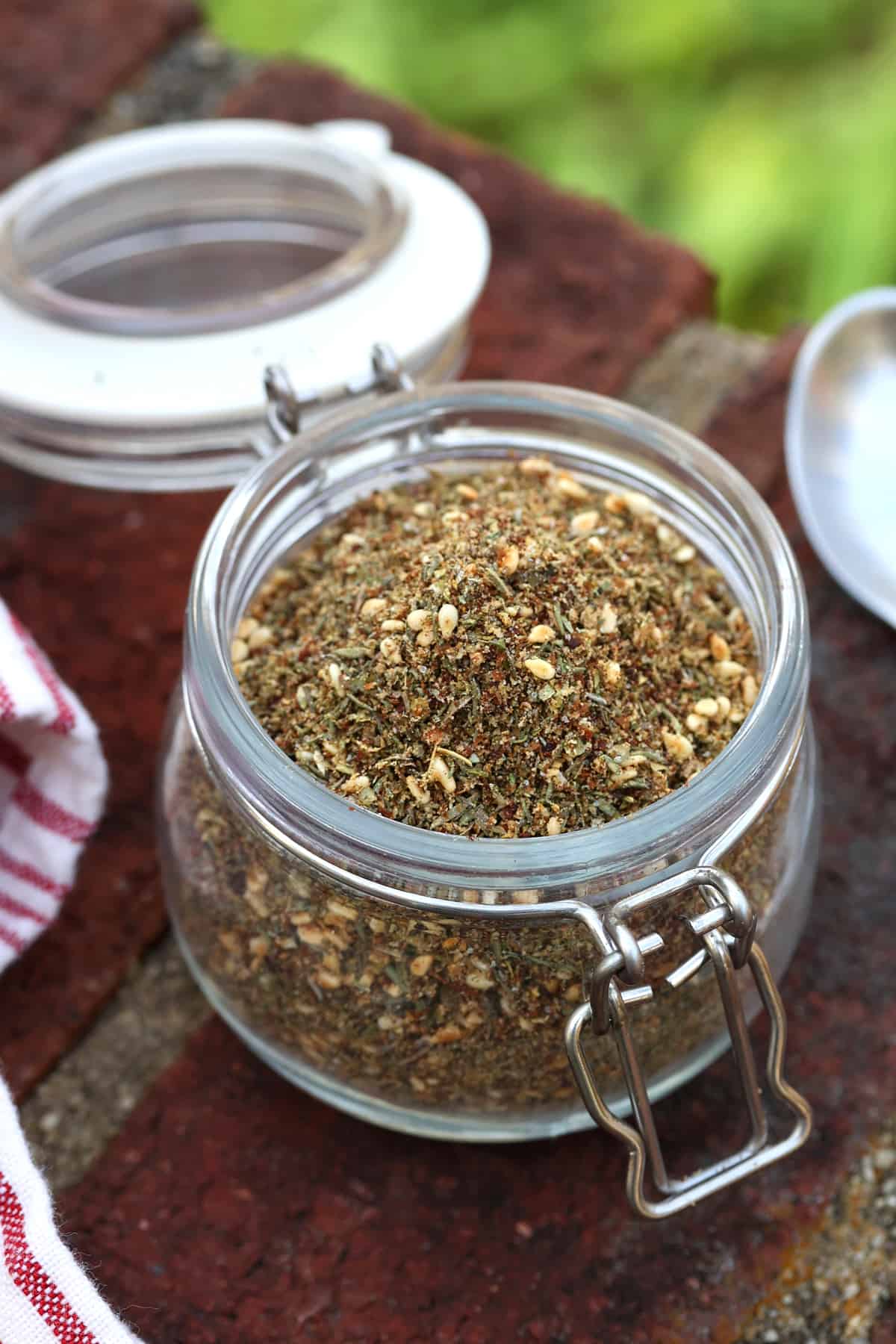
Why I Love This Seasoning Blend
Za’atar is one of my most favorite Middle Eastern spice blends. Another top competitor is Dukkah, which is very different but equally amazing. Whether you’ve never had za’atar before or your only experience has been with store-bought blends, I urge to try your hand at making your own – there is no comparison! This fabulous seasoning blend relies on quality herbs and spices to create a truly unforgettable combination of flavors that will transform your food.
What is Za’atar?
The Arabic word Za’atar refers to both a species of herb as well as to a seasoning blend. The Zaatar seasoning blend is used throughout the Middle East but has especially powerful association with Palestine. No one recipe is alike and there are probably as many variations as there are cooks. Nevertheless, there are some key defining ingredients which I’ll discuss further down. A versatile seasoning blend, the flavor of za’atar can be described as a combination of tangy, herbal, earthy, lemony, and nutty.
Two varieties of za’atar are green za’atar and red za’atar, the primary difference being the ratio of green herbs to the red sumac. I have encountered green za’atar far more often than the red variety in my travels and I also its balanced flavor more.
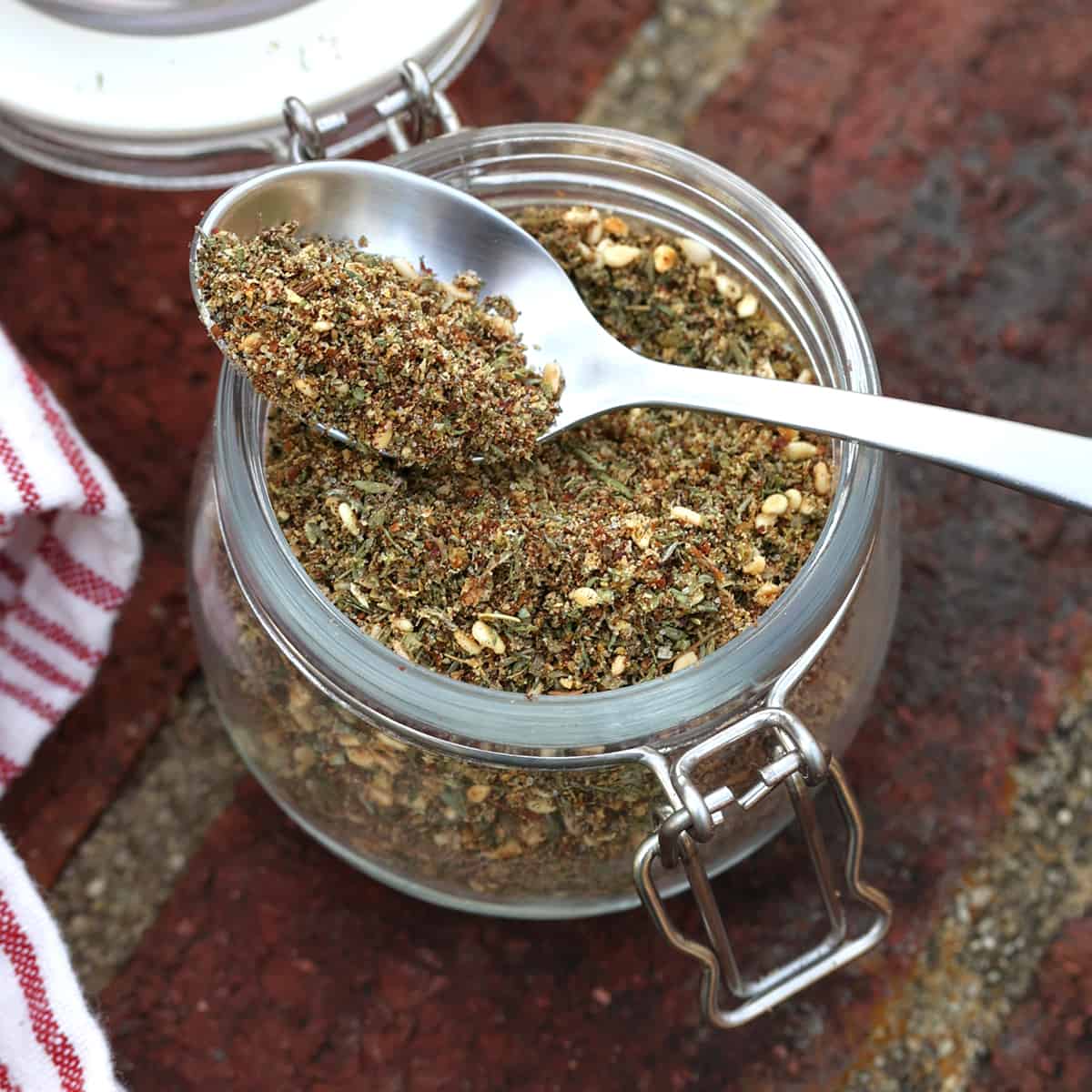
Key Ingredients
While many variations exist, there are three central ingredients that define za’atar: sesame seeds, thyme and sumac. The species of thyme (whether a wild species or the species native to Greece and Israel/Palenstine) varies by region. The other herbs and spices commonly included in za’atar are oregano, marjoram, coriander and cumin.
I mentioned earlier that the word za’atar also refers to a specific species of herb. There is some ambiguity as to which herb that is. Some believe it refers to Origanum Syriacum, also known as Syrian or Lebanese oregano and is also the herb that the bible refers to as hyssop. Other food historians believe it refers to a species of savory. Whichever the case, origanum syriacum is commonly used in the Middle East but is very difficult to find anywhere else. To try and replicate its unique flavor we are adding regular oregano, marjoram and savory, the combination of which imparts an excellent flavor.
What is Sumac?
One of the defining ingredients in za’atar is sumac, something you may not already be familiar with. It’s ground from the ripe, dried red berries of the deciduous shrub Rhus coriaria. It has a distinct tangy lemon flavor, though not as sour, and is widely used in Middle Eastern cooking. Its flavor cuts through and provides a nice balance to “heavier” spices and ingredients. For example, the Turkish döner kebabs I grew up eating in Germany always came sprinkled with ground sumac over the yogurt sauce which paired beautifully with the heavily spiced meat.
While sumac has a distinct flavor of its own it also, like salt, enhances the natural flavors of the foods to which it’s added. You can find sumac in many ethnic grocery stores in the Middle Eastern or Mediterranean sections. You can also find it online such as here on Amazon.
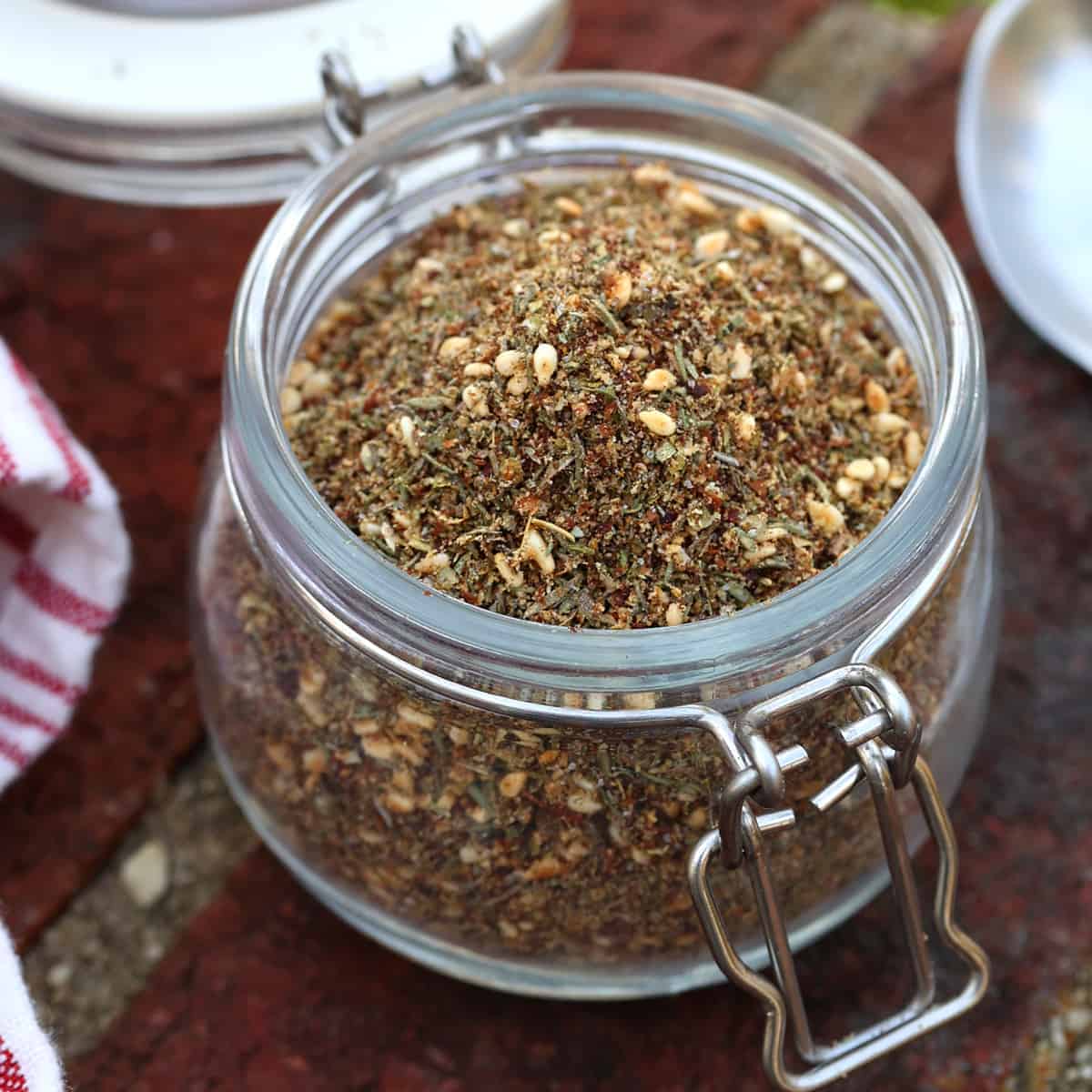
My Discovery of Za’atar in the Middle East
I first encountered za’atar years ago during my study abroad in Jerusalem. Its fragrance and flavor are vividly imprinted in my memory. All I have to do is close my eyes, open a jar of za’atar and inhale, and I’m instantly transported back to the Arab markets in Old Jerusalem.
Oh, the smells in those spice shops! Even as a 20 year old I could spend hours perusing those shops and stalls, geeking out over all the herbs and spices. Below left is a pic of me with a spice vendor in Jerusalem. Check out the large heap of green spices on the counter – that’s literally a third the size of some of the spice displays I saw in the Arab markets. Some of the elaborate pyramid-shaped spice displays were almost as tall as I was!

A common sight were tables or street carts laden with manakish, yeasted flatbread that’s spread with a paste of olive oil and za’atar and baked in the oven. It’s a classic Levantine dish and is absolutely delicious. I would also regularly buy sesame-studded bread shaped into rings that were sold with small bowls of za’atar for dipping.
Za’atar is special spice blend to me that carries a great many memories, among the very best.
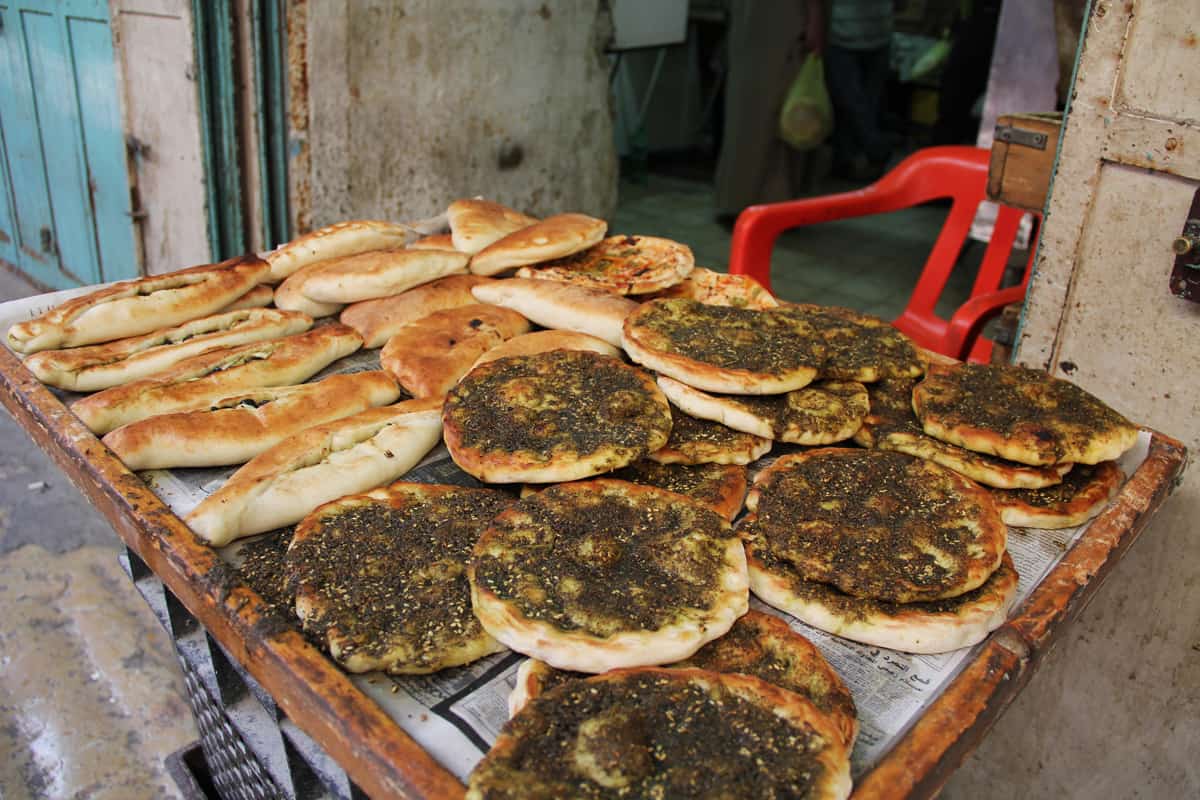
Za’atar Recipe
Let’s get started!
Toast the seeds and spices: Toast 2 tablespoons of the sesame seeds along with the cumin and coriander seeds in a dry skillet over medium heat until the sesame seeds turn golden and the spices are very fragrant. Be careful not to scorch them or they will turn bitter. Remove from heat and let them cool completely. Separately toast the remaining 1/2 tablespoon of sesame seeds and let them cool (reserve these to stir in at the very end).
Place the toasted seed/spice mixture in a spice grinder and coarsely grind it.
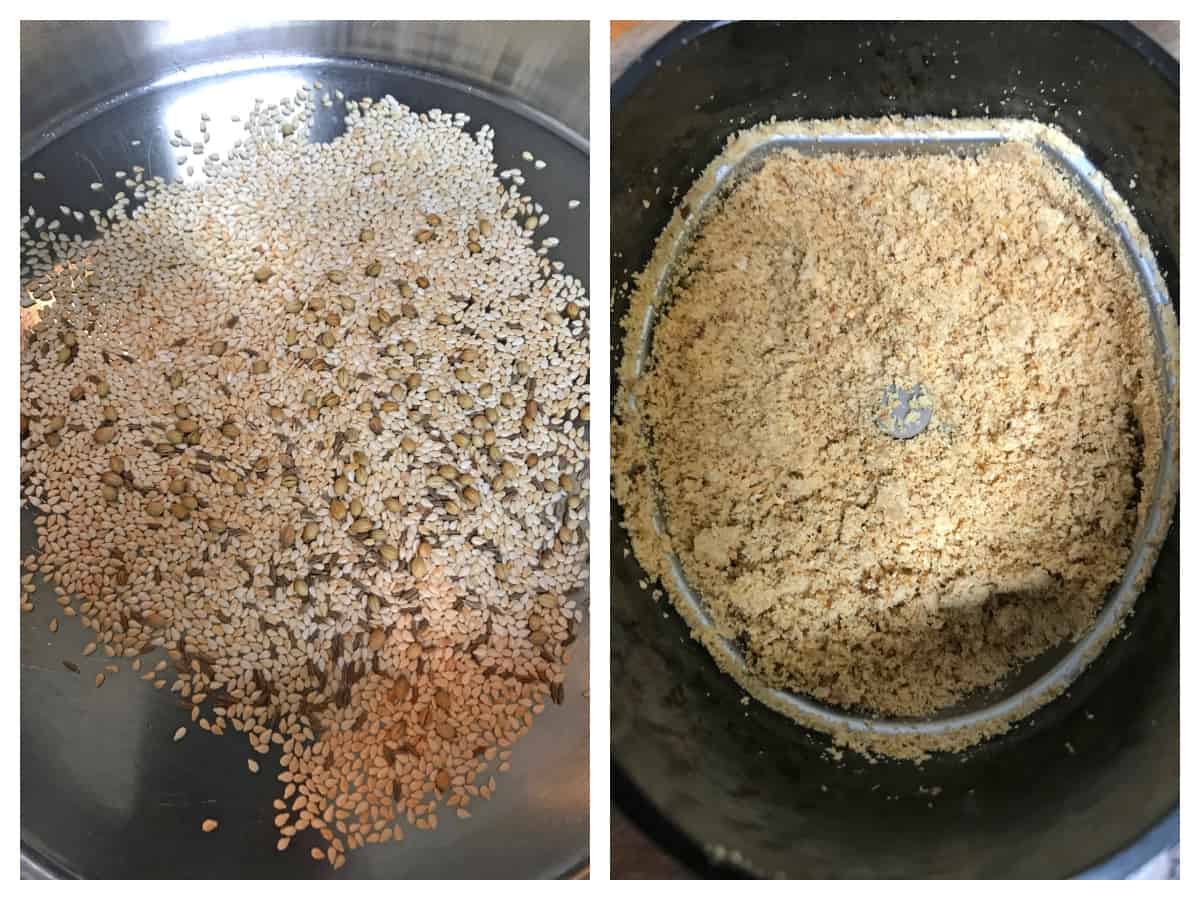
Add the herbs, sumac and salt and pulse just a couple of times to break up the herbs up into smaller pieces (i.e., do not grind into a fine powder). Alternatively, grind the ingredients using a mortar and pestle. Stir in the remaining toasted sesame seeds.
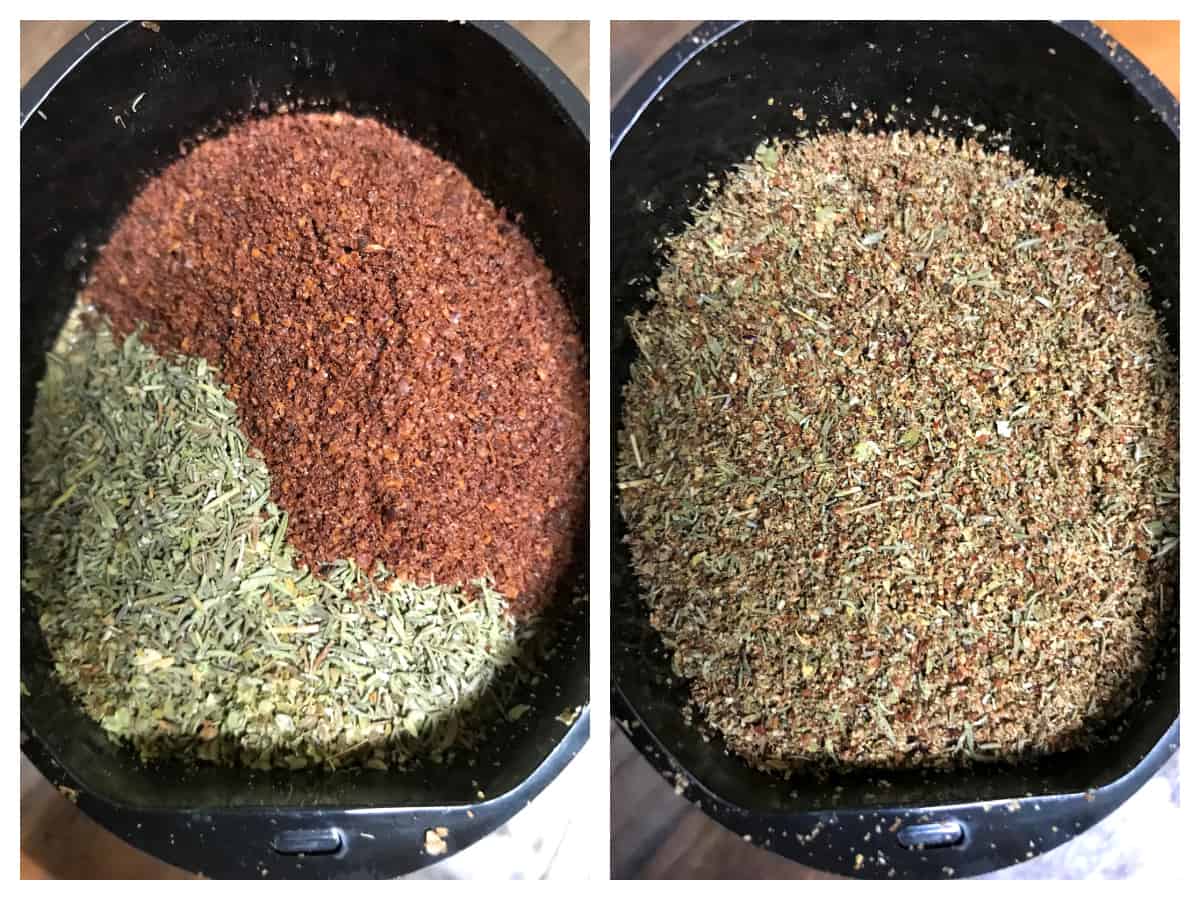
Stir the remaining toasted sesame seeds into the seasoning blend.
Transfer to an airtight jar and store in a dark, cool place where it will keep for several months.
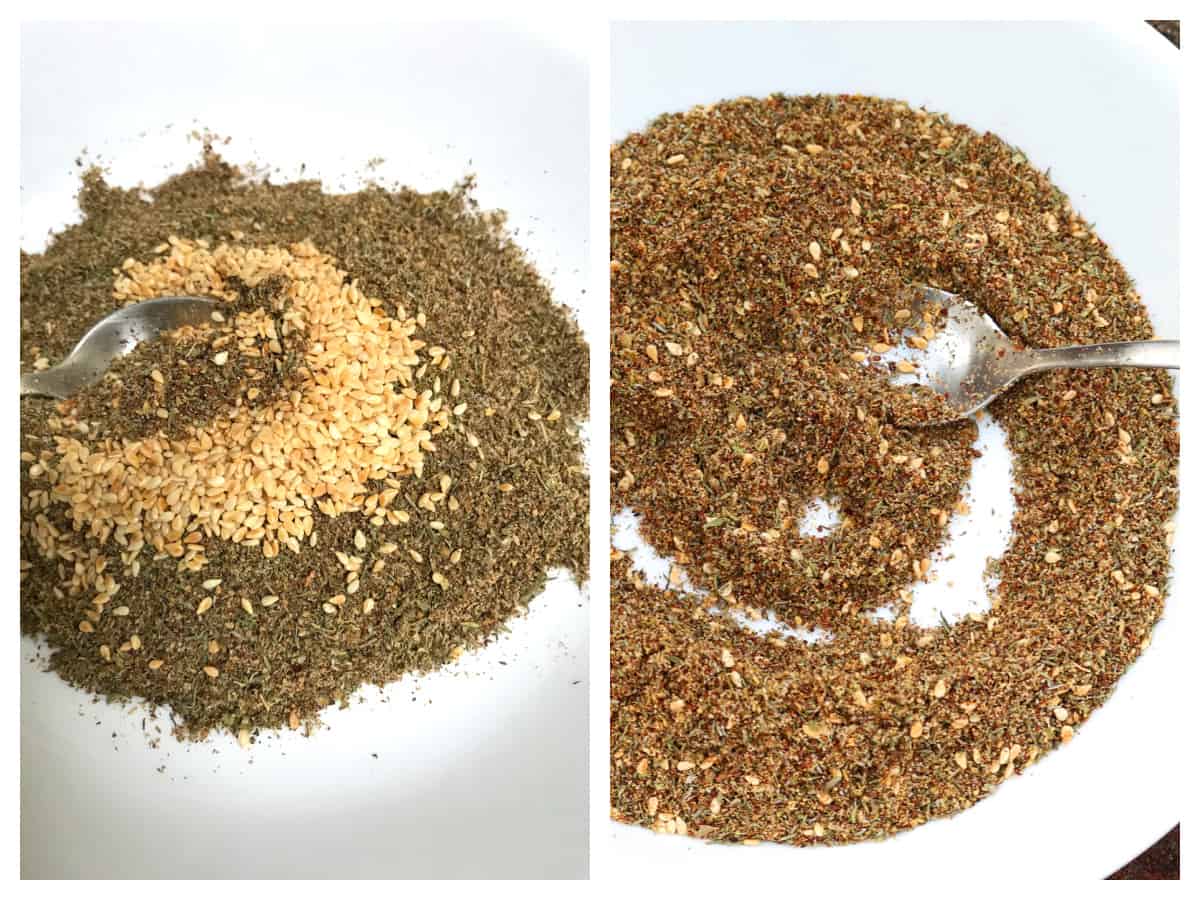
While homemade za’atar will keep for several months, for the best flavor I recommend using it with in a few weeks. This za’atar recipe makes a small batch so you can make it fresh every few weeks as needed.
Enjoy!
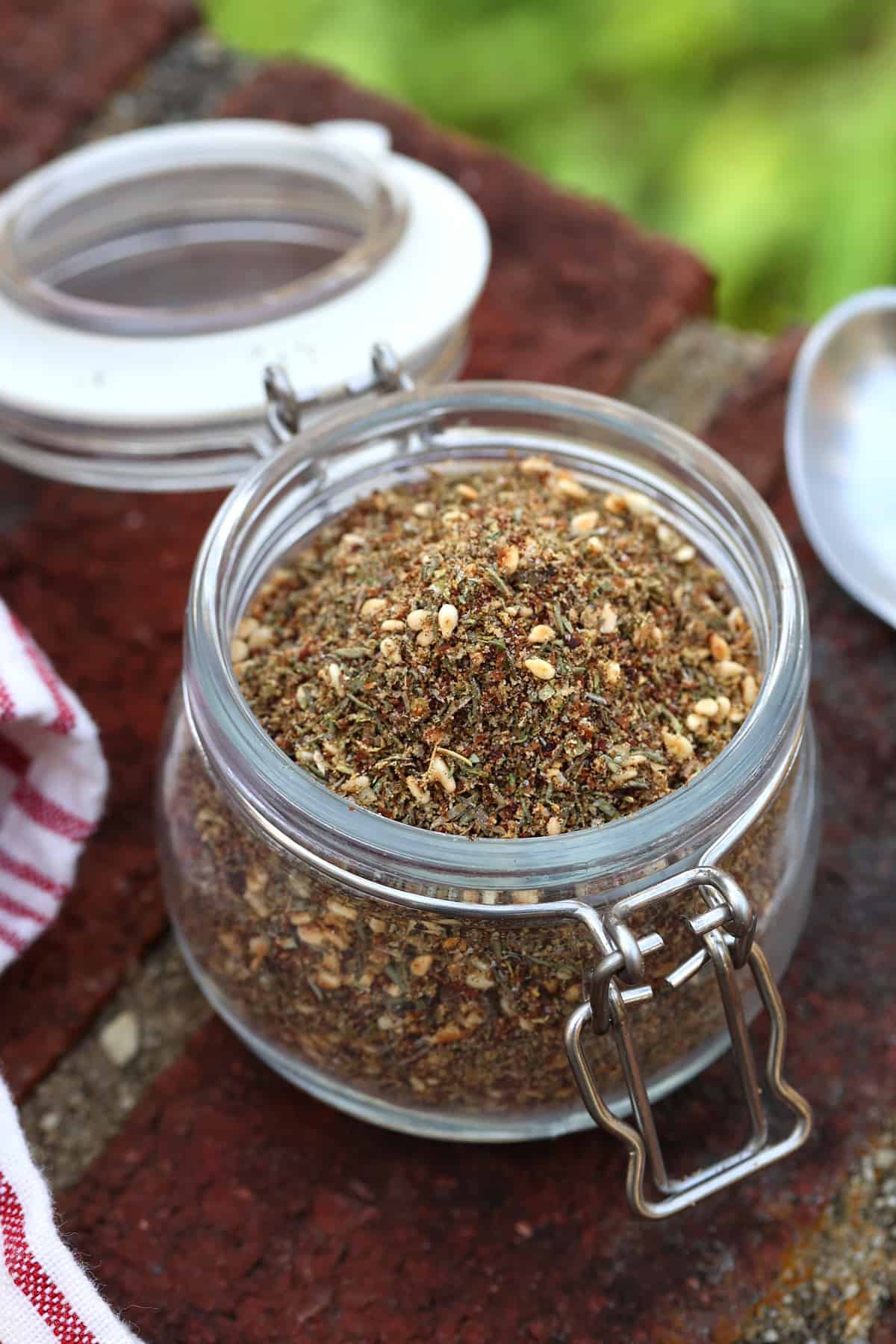
How to Use Za’atar
Za’atar is enjoyed with bread that is first dipped in olive oil followed by the spice blend. It is also combined with just enough olive to form a paste that is spread on dough and then baked as a seasoned flatbread known as man’ousheh or manakish. But there are many additional ways this fabulous seasoning blend can be enjoyed. Here are a few ideas:
- As a salad seasoning
- Sprinkled over slices of fresh tomatoes and cucumbers
- Sprinkled over grilled or roasted vegetables such as potatoes, grilled eggplant and cauliflower
- As a marinade for chicken or lamb
- Sprinkled over kabobs and skewered meat or veggies
- Added to your falafel mix
- Sprinkled over fried eggs
- Added to cream cheese, goat cheese, labneh or Greek yogurt for a cracker spread or dip
- Sprinkled over hummus or baba ganoush
- On sandwiches and wraps
- Sprinkled over popcorn
- Sprinkled over baked potatoes, baked sweet potatoes, baked potato wedges, French fries, or sweet potato fries
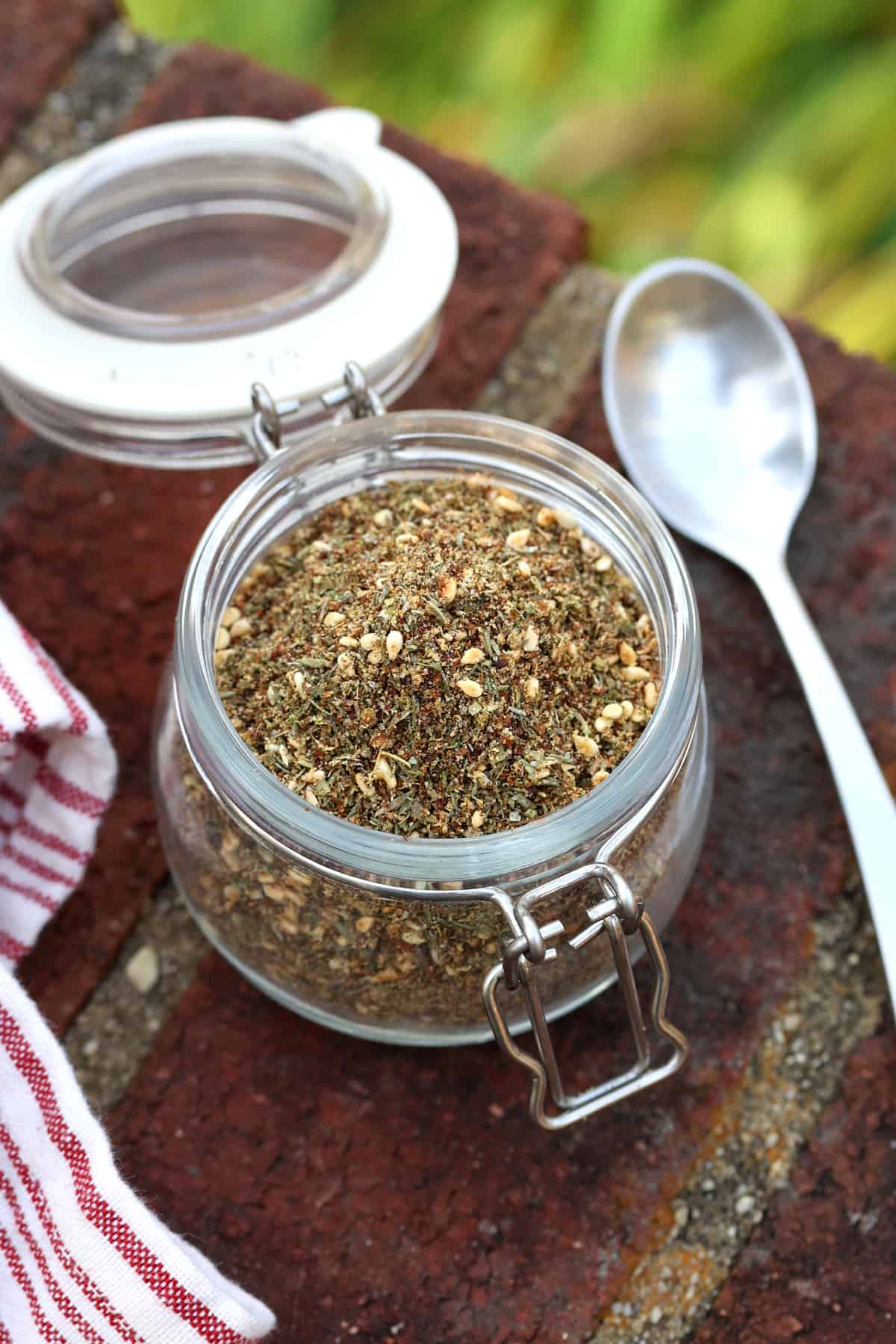
For more seasoning blends from around the world be sure to try my:
Save This Recipe
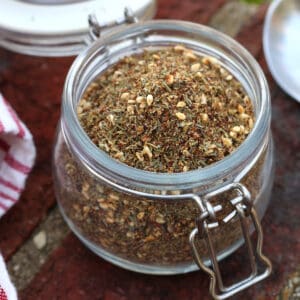
Za’atar (Middle Eastern Spice Blend)
Equipment
Ingredients
- 2 1/2 tablespoons white hulled sesame seeds
- 1 teaspoon coriander seeds
- 1/2 teaspoon cumin seeds
- 2 tablespoons ground sumac
- 2 tablespoons dried thyme
- 1 tablespoon dried oregano
- 1 tablespoon dried marjoram
- 1 teaspoon dried savory (optional but recommended)
- 1 teaspoon sea salt
Instructions
- Toast the seeds and spices: Toast 2 tablespoons of the sesame seeds along with the cumin and coriander seeds in a dry skillet over medium heat until the sesame seeds turn golden and the spices are very fragrant. Be careful not to scorch them or they will turn bitter. Remove from heat and let them cool completely. Separately toast the remaining 1/2 tablespoon of sesame seeds and let them cool (reserve these to stir in at the very end).Grind the seeds, spices and herbs: Place the toasted seed/spice mixture in a spice grinder and coarsely grind it. Add the herbs, sumac and salt and pulse just a couple of times to break up the herbs up into smaller pieces (i.e., do not grind into a fine powder). Alternatively, grind the ingredients using a mortar and pestle. Stir in the remaining toasted sesame seeds. Transfer to an airtight jar and store in a dark, cool place where it will keep for several months.
Originally published on The Daring Gourmet January 22, 2022



















This was really pretty incredible. I had everything I needed except for the savory and even without it this za’tar was one of the best things I’ve tasted. We ate it with bread and olive oil. It was amazing how such a simple course was so satisfying. This blend and this recipe will be a new staple in my home.
That’s wonderful, Jack, I’m so happy to hear that, thank you!
Last Sunday in the sermon our pastor talked about his time in the Middle East, specifically about the scent of freshly baked flatbread – which was then improved by a generous sprinkling of za’atar. However when we had communion there was no za’atar to put on the bread! I’ve made it before, but I’m going to use your recipe and then secretly put a little dish on the communion table next time. :-)
Ha, I love that, that’s a terrific plan Sonnie! :)
Great seasoning and blend of flavors and the balance is spot on.
Kimberly,
I will be growing wild za’atar (the herb) this coming spring. Doing some research, it seems that dried oregano, margoram, and thyme are combined to approximate the taste of real za’atar. If you were to guess (despite Sherlock Holmes’s admonition), should all of these herbs be replaced by dried za’atar, or should 1 or more be retained.
I’m afraid that my palate isn’t sophisticated enough to make that call. You may well ask “why does it matter, then?”. Probably just the engineer in me.
Thanks,
Joe
Hi Joe, I’m no engineer but the “whys” of everything equally intrigue me, so I understand your drive to know :) Yes, I talk about this very thing in my article: “Za’atar also refers to a specific species of herb. There is some ambiguity as to which herb that is. Some believe it refers to Origanum Syriacum, also known as Syrian or Lebanese oregano and is also the herb that the bible refers to as hyssop. Other food historians believe it refers to a species of savory. Whichever the case, origanum syriacum is commonly used in the Middle East but is very difficult to find anywhere else. To try and replicate its unique flavor we are adding regular oregano, marjoram and savory”.
I’m not sure which species of za’atar you’ll be growing but in the end it looks like there isn’t a whole lot of consensus anyway, though origanum syriacum seems to be the most commonly used. I’d have to try the herb in the blend in order to decide. Once you have your first batch of homegrown za’atar you can conduct an experiment: you can make two tiny batches of the seasoning blend – one with the ingredients as called for in the recipe, and one that omits the marjoram, oregano, and savory and uses your za’atar herb in their place (equal amount). Then do a side by side taste comparison. My guess is that I would still likely include at least one of those other herbs.
(And this type of response, gentle readers, is one the reasons why I love The Daring Gourmet so much)
The species that I will be growing is Origanum Syriacum (rather unhelpfully spelled Syriaca on the seed package). Interestingly enough, I will also be planting hyssop (Hyssop Officinalis). That, of course, gives me a whole other dimension of combinations to try out. And that doesn’t even include the possible use of the various types of savory.
I’m not sure the degree to which I want to experiment with this, so I’ll probably try the complete replacement of the three herbs with Origanum Syriacum. If I like it, end of experiments.
I’ll let you know how it turns out, but it obviously won’t be for a while.
Joe
Well thank you for that kind compliment, JoeW! :) As a fellow gardener I’m excited for your upcoming herb-growing adventures. Good luck and happy eating! :)
Excellent seasoning recipe. It’s so good that I could eat it by spoonfuls. The only thing I left out was the savory, as I didn’t have it on hand and it’s not so readily available in the markets near me. I don’t think I will ever purchase store bought Za’atar again, your recipe is better! Thank you for sharing.
Thank you so much, ForeverMama, I’m thrilled that you enjoyed it!
Thank you for the Zaatar Spice Mix recipe.
I’ve also read your writing about Döner Kebab, which is a Turkish street food, you used to have living in Germany. The thing is I’ve never had Döner Kebab in any country outside Turkey except Greece and other Balkan countries. Because in Turkey, Döner is not made from sausages meat but from a good cut such as around rib. Second, It’s not minced but lean thin steaks put together and between some layers on the top is fat. Second, never ever spices used except Black Pepper. Also, never chilli or anything hot. Thirdly never served with yogurt sauce or Sumac. Yes, we eat a lot of yogurt but not put in a roll or between bread. Again, we eat a lot of salad but never served between the bread with doner. If you’ve been to Turkey, you’d see Döner is made from steak not mince, and also served with couple of chips and tomato between inside the bread with Döner Meat. The staff serving would ask if you would like your fermented green pepper not chili or chili. The same for the Shish Kebab or Urfa Kebab. I see sometimes on Youtube recipes for these from people who live in Germany or England, or India loading strange spices even a Turkish person never heard in their life or used such as Coriander or Coriander seeds 😊 Shish Kebab and Urfa Kebab also does not have any spices. Spices are good for body as much as I know but can not have with Turkish food or recipes. Then It feels not Turkish to me and don’t like it. That’s the reason I tried Kebabs overseas (not counting Balkan countries) and throw away into a bin. I can’t talk about Arabic or Israeli Shawarma if they use spices in their Shawarma in their country. However, I have been in Qatar and had Shawarma there and tasted a bit of cinnamon, and found the food tasty. But didn’t have that as Turkish Döner Kebab or Greek Kebab.
Danke für leckere rezepte 👍🙏
The only time I used seasoning salt I swelled up like a blimp and my feet were so swollen I could hardly walk. Our stores in this tiny town don’t carry all of your exotic spices.
Hi Shirley, that definitely sounds like an allergic reaction to something in that blend – not fun! It’s challenging for me to find certain ingredients locally as well, so I often order them online. I provide some links in the recipe by way of online suggestions.
This sounds so good Kimberley, but before I make it I would like to ask whether you used summer or winter savory? Many thanks.
Hi Ruth! Thanks for asking – you can use either but I use summer savory (it’s milder/sweeter and more delicate, winter is more bitter). Happy cooking! :)
This is now a staple at my kitchen! Thank you!
I’m glad you enjoyed it, Sandra, thank you!
Great Blend. I will use less salt in my next batch, maybe just half a teaspoon, but love this combination of herbs and spices. Thank you.
Thank you, Sheinagh, I’m happy you enjoyed it!
Amazing flavor. We love it on popcorn most.
Agreed, Krystle, it’s so good on popcorn!
This sounds like the perfect blend!! I love the flavors!
I love this blend!! SO delicious!!
I’m glad you enjoyed it, Katerina, thank you! :)
I love this idea! So simple, pretty and delicious!
This is such a perfect blend! Delicious and so easy to make!